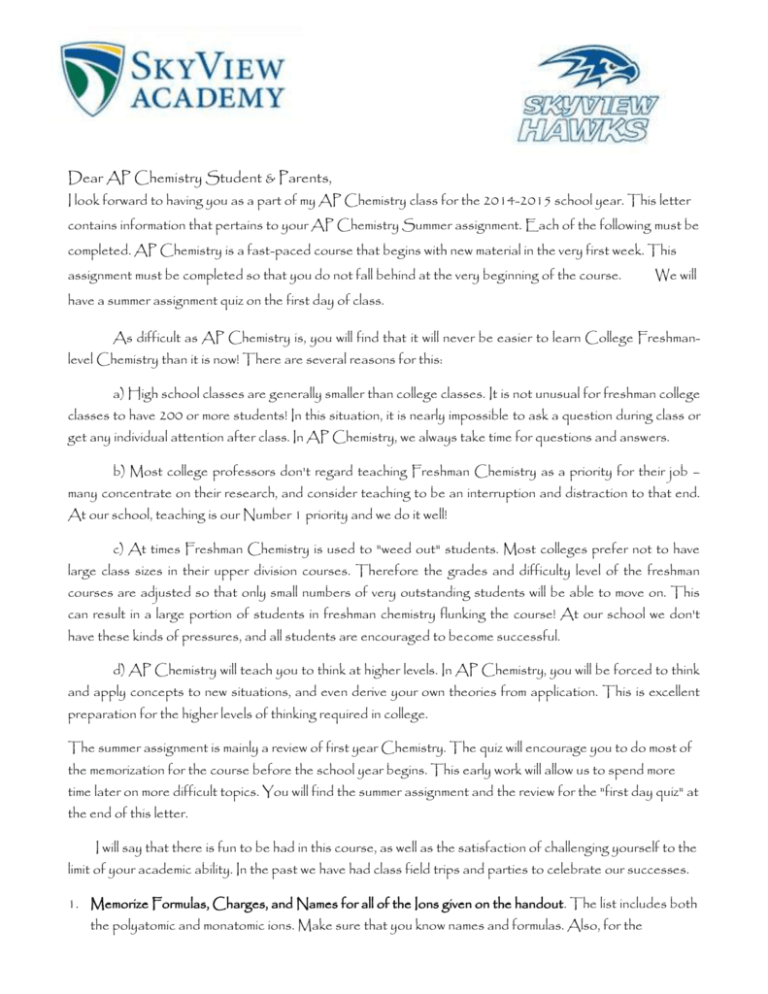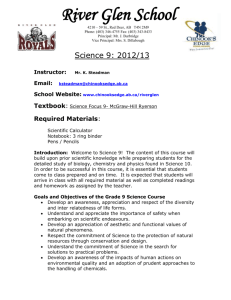I look forward to having you as a part of my AP Chemistry class for
advertisement

Dear AP Chemistry Student & Parents, I look forward to having you as a part of my AP Chemistry class for the 2014-2015 school year. This letter contains information that pertains to your AP Chemistry Summer assignment. Each of the following must be completed. AP Chemistry is a fast-paced course that begins with new material in the very first week. This assignment must be completed so that you do not fall behind at the very beginning of the course. We will have a summer assignment quiz on the first day of class. As difficult as AP Chemistry is, you will find that it will never be easier to learn College Freshmanlevel Chemistry than it is now! There are several reasons for this: a) High school classes are generally smaller than college classes. It is not unusual for freshman college classes to have 200 or more students! In this situation, it is nearly impossible to ask a question during class or get any individual attention after class. In AP Chemistry, we always take time for questions and answers. b) Most college professors don't regard teaching Freshman Chemistry as a priority for their job – many concentrate on their research, and consider teaching to be an interruption and distraction to that end. At our school, teaching is our Number 1 priority and we do it well! c) At times Freshman Chemistry is used to "weed out" students. Most colleges prefer not to have large class sizes in their upper division courses. Therefore the grades and difficulty level of the freshman courses are adjusted so that only small numbers of very outstanding students will be able to move on. This can result in a large portion of students in freshman chemistry flunking the course! At our school we don't have these kinds of pressures, and all students are encouraged to become successful. d) AP Chemistry will teach you to think at higher levels. In AP Chemistry, you will be forced to think and apply concepts to new situations, and even derive your own theories from application. This is excellent preparation for the higher levels of thinking required in college. The summer assignment is mainly a review of first year Chemistry. The quiz will encourage you to do most of the memorization for the course before the school year begins. This early work will allow us to spend more time later on more difficult topics. You will find the summer assignment and the review for the "first day quiz" at the end of this letter. I will say that there is fun to be had in this course, as well as the satisfaction of challenging yourself to the limit of your academic ability. In the past we have had class field trips and parties to celebrate our successes. 1. Memorize Formulas, Charges, and Names for all of the Ions given on the handout. The list includes both the polyatomic and monatomic ions. Make sure that you know names and formulas. Also, for the monatomic ions make sure you know both the stock and classical names. You must know how to write correct chemical formulas using these ions. 2. Memorize Solubility Rules for the Soluble and Insoluble Ionic Compounds. You need to be able to look at the formula for a compound and know if that compound will be soluble or insoluble in a solution. 3. Memorize Formulas and Names for the Common Acids and Compounds: a. Hydrochloric Acid – HCl s. Ca(OH)2 slaked lime (lime water) b. Sulfuric Acid – H2SO4 c. Phosphoric Acid – H3PO4 t. CaSO4 gypsum, plaster of paris d. Acetic Acid – HC2H3O2 u. Fe3O4 or Fe2O3 rust e. Carbonic Acid – H2CO3 v. HCHO formaldehyde f. Nitric Acid – HNO3 g. AlK(SO4)2·12H2O alum h. CH4 methane i. C6H6 benzene j. C10H8 naphthalene (mothballs) k. CHCl3 chloroform l. CH3OH methyl alcohol or methanol (wood alcohol) m. C2H5OH ethyl alcohol or ethanol (drinking alcohol) n. CH3COCH3 acetone o. C3H5(OH)3 glycerin p. C6H8O6 L-ascorbic acid (vitamin C) q. CaCO3 chalk, marble, limestone r. CaO quicklime w. H2O water x. Hg quicksilver y. K2CO3 potash z. MgO magnesia aa. MgSO4 epsom salts bb. NH3 ammonia cc. N2O laughing gas dd. Na2CO3 soda ash ee. NaCl table salt ff. NaHCO3 baking soda gg. NaNO3 saltpeter hh. NaOCl bleach ii. NaOH caustic soda or lye jj. SiO2 sand, quartz 4. Review basic chemistry concepts while completing the AP Chemistry Summer Assignment Worksheet to make sure that you are ready for the quiz on our first day. You will have a quiz on the first day of class when you return from break. Please do not put this assignment off until the last minute. You will not be able to get it done. A failing grade on this test will tell me that you are not ready to do the work necessary in AP Chemistry and you will be asked to attend tutoring for the first two weeks of the semester. Please do not hesitate to contact me if you have any questions. I can be reached by email. Thank you in advance for your cooperation and hard work. I look forward to having you in class! It will be a blast…sometimes quite literally! Sincerely, Mr. Youngberg (AKA-Mr. Y) Email: threegorgesdam@comcast.net Please type “AP Chemistry” your email title. Chemistry Study Sheet: Ions and Ionic Substances Cations Strontium Sr 2 Fluoride F 1 Tin (II) Sn 2 (IV) Sn 4 Hydroxide OH 1 Ammonium NH 41 Zinc Zn 2 Hypochlorite ClO 1 Antimony (III) Sb 3 (V) Sb 5 Anions Iodide I Arsenic (III) As 3 (V) As 5 Acetate C2H 3O21 Monohydrogen phosphate HPO42 Barium Ba 2 Arsenate AsO43 Nitride N Bicarbonate(carbonic acid) HCO31 Nitrate NO31 Calcium Ca 2 Binoxalate HC2O41 Nitrite NO21 Cadmium Cd 2 Bisulfate (sulfuric acid) HSO 41 Oxalate C 2O 42 Chromium (II) Cr 2 (III) Cr 3 Bisulfide(Hydrosulfuric acid) HS 1 Oxide O 2 Cobalt (II) Co 2 (III) Co 3 Bisulfite(sulfurous acid) HSO31 Perchlorate ClO41 Copper (I) Cu 1 (II) Cu 2 Borate BO33 Permanganate MnO 41 3 Aluminum Al 3 Bismuth (III) Bi (V) Bi Hydrogen H 5 1 Bromide Br 1 1 3 Peroxide O22 Iron (II) Fe 2 (III) Fe 3 Carbonate CO32 Phosphate PO 43 Lead (II) Pb 2 (IV) Pb 4 Chlorate ClO31 Phosphide P Chloride Cl 1 Silicate SiO32- Chlorite ClO21 Sulfate SO42 Chromate CrO 42 Sulfide S 2 Cyanide CN 1 Sulfite SO32 Dichromate Cr2O72 Thiocyanate SCN 1 Lithium Li 1 Magnesium Mg 2 2 Manganese (II) Mn (IV) Mn 1 Mercury (I) Hg (II) Hg Nickel (II) Ni 2 Potassium K 1 Silver Ag 1 Sodium Na 1 (III) Ni 3 2 4 Dihydrogen phosphate H 2PO41 Ferrocyanide Fe (CN )64 Ferricyanide Fe (CN )63 3 Solubility Rules Rule 1 Ion(s) Cl-, Br- Rule , I- Exceptions Most chlorides, bromides, and AgCl, AgBr, AgI, Hg2Cl2, iodides are soluble. Hg2Br2, Hg2I2, PbCl2, PbBr2, PbI2 (silver, mercury and lead) 2 F- Most fluorides are soluble MgF2, CaF2, SrF2, BaF2, PbF2 (magnesium, lead, calcium, strontium, and barium) 3 SO4 2- Most sulfates are soluble CaSO4, SrSO4, BaSO4, Ag2SO4, Hg2SO4, and PbSO4 (silver, mercury and lead, calcium, strontium, and barium) 4 CO32- Most carbonates are insoluble Group 1A and ammonium carbonates 5 PO43- Most phosphates are insoluble Group 1A and ammonium phosphates 6 S2- Most sulfides are insoluble Group 1A and ammonium sulfides 7 OH- Most hydroxides are insoluble Group 1A hydroxides and Ca(OH)2, Sr(OH)2, and Ba(OH)2 (calcium, strontium, barium) 8 Li+, Na+, Group 1A and ammonium K+, NH4+ compounds are soluble None (Alkali metals and ammonium) 9 C2H3O2, Acetates, nitrates, chlorates, and None NO3-, perchlorates are soluble ClO3-, ClO4- AP Chemistry Summer Assignment The following assignment is to be completed and brought on the first day of class. Nomenclature Name these binary compounds of two nonmetals. 1. IF7 4. N2O4 7. PCl3 2. N2O5 5. As4O10 8. S2Cl2 3. XeF2 6. SF6 Name these binary compounds with a fixed charge metal. 9. AlCl3 12. KI 15. CaF2 10. MgO 13. SrBr2 16. Al2O3 11. BaI2 14. Na2S Name these binary compounds of cations with variable charge. 17. CuCl2 20. PbCl4 23. AuI3 18. Fe2O3 21. Cu2S 24. CoP 19. SnO 22. HgS Name these compounds with polyatomic ions. 25. Fe(NO3)3 28. Ca(ClO3)2 31. NH4NO2 26. NaOH 29. KNO2 32. Cu2Cr2O7 27. Cu2SO4 30. NaHCO3 Name these binary acids 33. HCl 34. HI Name these acids with polyatomic ions. 35. HClO4 38. H3PO4 41. H2C2O4 36. H2SO4 39. HNO2 42. H2CO3 37. HC2H3O2 40. H2CrO4 Name these compounds appropriately. 43. CO 48. OF2 53. CuCr2O7 44. NH4CN 49. LiMnO4 54. K2O 45. HIO3 50. HClO 55. FeF3 46. NI3 51. HF 56. KC2H3O2 47. AlP 52. SO2 57. MnS 58. Tin (IV) phosphide 62. Sulfurous acid 66. Gallium arsenide 59. Copper (II) cyanide 63. Lithium silicate 67. Cobalt (II) chromate 60. Magnesium hydroxide 64. Potassium nitride 68. Zinc fluoride 61. Sodium peroxide 65. Chromium (III) carbonate 69. Dichromic acid Write the formulas. Solubility rules Review solubility rules and identify each of the following compounds as soluble or insoluble in water. 70. Na2CO3 75. (NH4)2S 80. PbCl2 71. CoCO3 76. AgI 81. CuSO4 72. Pb(NO3)2 77. Ni(NO3)2 82. Li2O 73. K2S 78. KI 83. Mn(C2H3O2)2 74. BaSO4 79. FeS 84. Cr(OH)3 85. AgClO3 86. Sn(SO3)4 87. FeF2 Predict whether each of these double replacement reactions will give a precipitate or not based on the solubility of the products. If yes, identify the precipitate. 88. silver nitrate and potassium chloride 89. magnesium nitrate and sodium carbonate 90. strontium bromide and potassium sulfate 91. cobalt (III) bromide and potassium sulfide 92. ammonium hydroxide and copper (II) acetate 93. lithium chlorate and chromium (III) fluoride Balancing Equations Balance the following equations with the lowest whole number coefficients. 94. S8 + O2 SO3 95. C10H16 + Cl2 96. Fe + O2 C + 98. KClO3 HCl Fe2O3 97. C7H6O2 + O2 CO2 + H2O 99. H3AsO4 KCl + O2 As2O5 + H2O 100. V2O5 + HCl VOCl3 + H2O 101. Hg(OH)2 + H3PO4 Hg3(PO4)2 + H2O Stoichiometry and Limiting Factor 102. Given the equation below, what mass of water would be needed to react with 10.0g of sodium oxide? Na2O + H2O 2NaOH 103. What mass of sodium choride is formed along with 45.0g of oxygen gas? 2NaClO3 2NaCl + 3O2 104. What mass of water will be produced when 100.0g of ammonia is reacted with excess oxygen? 4NH3 + 5O2 4NO + 6 H2O 105. If the reaction in #104 is done with 25.0g of each reactant, which would be the limiting factor? 106. Na2S + 2AgNO3 Ag2S + 2NaNO3 a. If the above reaction is carried out with 50.0g of sodium sulfide and 35.0g of silver nitrate, which is the limiting factor? b. What mass of the excess reactant remains? c. What mass of silver sulfide would precipitate? 107. What volume of hydrogen gas (measured at STP) would result from reacting 75.0g of sodium hydroxide with 50.0g of aluminum? 6NaOH + 2Al 2Na3AlO3 + 3H2






